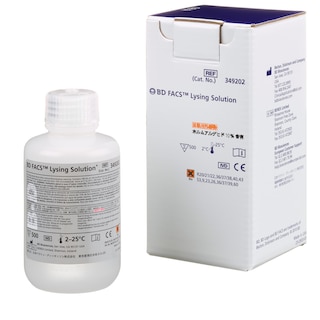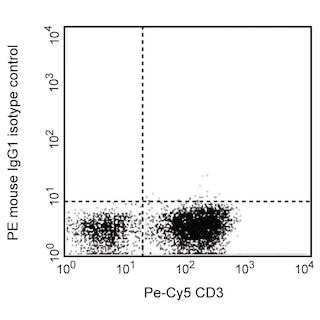-
Your selected country is
Middle East / Africa
- Change country/language
Old Browser
This page has been recently translated and is available in French now.
Looks like you're visiting us from {countryName}.
Would you like to stay on the current country site or be switched to your country?


.png)

Two-color flow cytometric analysis of TCR Vα7.2 expression on human peripheral blood cells. Human whole blood was stained with BD Horizon™ BV421 Mouse Anti-Human CD3 antibody (Cat. No. 562426/562427) and either PE Mouse IgG1, κ Isotype Control (Cat. No. 554680; Left Plot) or PE Mouse Anti-Human TCR Vα7.2 antibody (Cat. No. 566739; Right Plot). Erythrocytes were lysed with BD Pharm Lyse™ Lysing Buffer (Cat. No. 555899). Pseudocolor density plots showing the correlated expression of CD3 versus TCR Vα7.2 (or Ig Isotype control staining) were derived from gated events with the forward and side light-scatter characteristics of viable lymphocytes. Flow cytometry and data analysis were performed using a BD LSRFortessa™ Cell Analyzer System and FlowJo™ software.
.png)

BD Pharmingen™ PE Mouse Anti-Human TCR Vα7.2
.png)
Regulatory Status Legend
Any use of products other than the permitted use without the express written authorization of Becton, Dickinson and Company is strictly prohibited.
Preparation And Storage
Product Notices
- This reagent has been pre-diluted for use at the recommended Volume per Test. We typically use 1 × 10^6 cells in a 100-µl experimental sample (a test).
- An isotype control should be used at the same concentration as the antibody of interest.
- Source of all serum proteins is from USDA inspected abattoirs located in the United States.
- Caution: Sodium azide yields highly toxic hydrazoic acid under acidic conditions. Dilute azide compounds in running water before discarding to avoid accumulation of potentially explosive deposits in plumbing.
- For fluorochrome spectra and suitable instrument settings, please refer to our Multicolor Flow Cytometry web page at www.bdbiosciences.com/colors.
- Please refer to www.bdbiosciences.com/us/s/resources for technical protocols.
Companion Products






The OF-5A12 monoclonal antibody specifically recognizes the human variable alpha 7.2 region of the T cell receptor for antigen (TCR Vα7.2) that is joined with the Jα33 segment to form an invariant TCR which is characteristically expressed by mucosal-associated invariant T cells (MAIT cells). MAIT cell recognition of antigen is restricted by MHC-related molecule 1 (MR1), a nonpolymorphic Class Ib Major Histocompatibility Complex (MHC) molecule, that associates with β2-microglobulin. MAIT cells are found in human peripheral blood, mesenteric lymph nodes, liver, and mucosa associated with the lungs and intestines. MAIT cells play a role in detecting and fighting off microbial infections. The specificity of OF-5A12 for the TCR Vα7.2 was confirmed by its ability to block the binding of another human TCR Vα7.2-specific antibody, 3C10, to MAIT cells.

Development References (3)
-
Godfrey DI, Uldrich AP, McCluskey J, Rossjohn J, Moody DB. The burgeoning family of unconventional T cells. Nat Immunol. 2015; 16(11):1114-1123. (Biology). View Reference
-
Gold MC, Cerri S, Smyk-Pearson S, et al. Human mucosal associated invariant T cells detect bacterially infected cells. PLoS Biol. 2010; 8(6):e1000407. (Clone-specific). View Reference
-
Gold MC, Eid T, Smyk-Pearson S, et al. Human thymic MR1-restricted MAIT cells are innate pathogen-reactive effectors that adapt following thymic egress. Mucosal Immunol. 2013; 6(1):35-44. (Immunogen: Blocking, Flow cytometry, Fluorescence activated cell sorting). View Reference
Please refer to Support Documents for Quality Certificates
Global - Refer to manufacturer's instructions for use and related User Manuals and Technical data sheets before using this products as described
Comparisons, where applicable, are made against older BD Technology, manual methods or are general performance claims. Comparisons are not made against non-BD technologies, unless otherwise noted.
For Research Use Only. Not for use in diagnostic or therapeutic procedures.
Report a Site Issue
This form is intended to help us improve our website experience. For other support, please visit our Contact Us page.